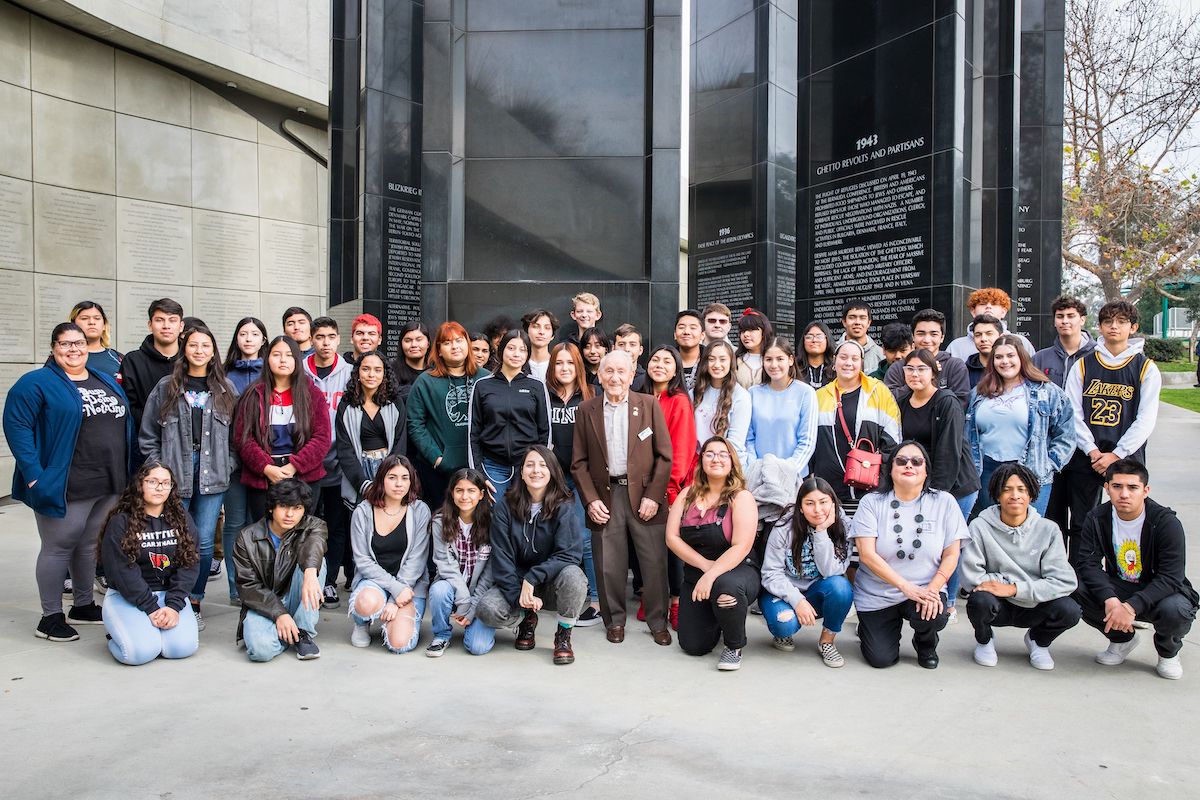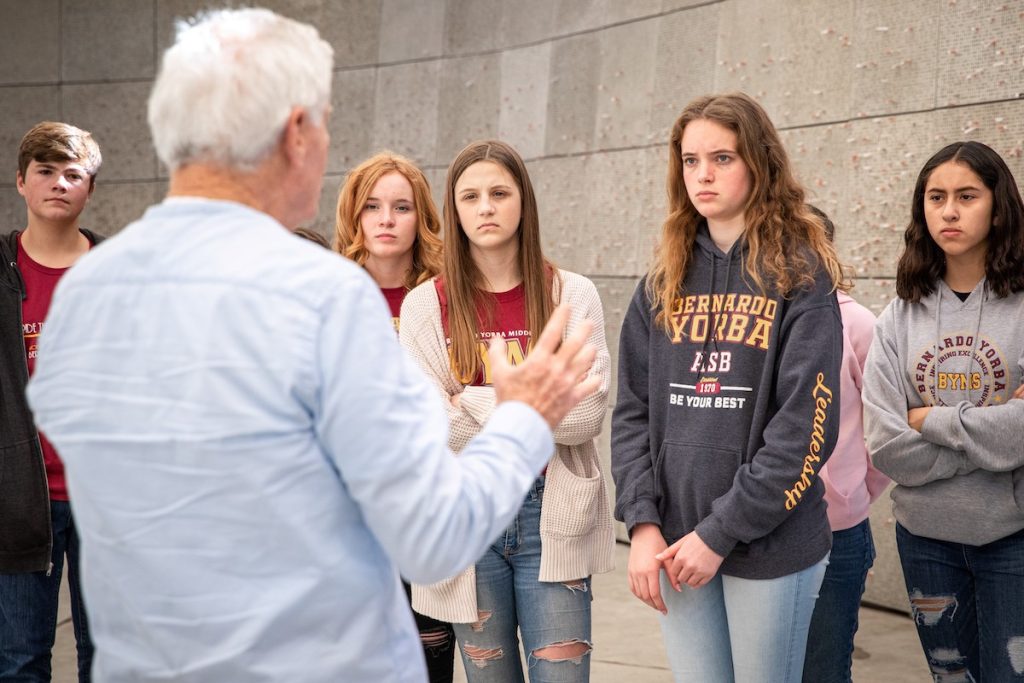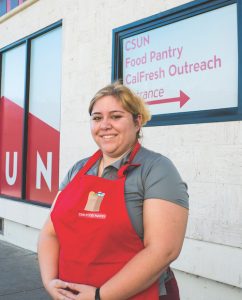Holocaust Museum

Holocaust Museum LA was founded in 1961 by a group of survivors who met each other in an ESL class at a Hollywood high school – just 16 years after the end of World War II, making HMLA the oldest Holocaust museum in the country. In its more than half a century of existence, the museum has been grounded in making sure the Holocaust is never forgotten by teaching the lessons and the social relevance of the Holocaust, and in empowering students and visitors to stand up and speak out against antisemitism in all forms of hate.
Surprisingly, given the passage of time, survivors of the atrocities still participate integrally in the museum’s activities. Participants in the museum’s tours not only get a 90-minute immersive experience in the history and artifacts from the Holocaust, but also usually have the opportunity to interact with a Holocaust survivor who shares stories of their struggles to encourage people to treat each other equally, with dignity and respect, to ensure history doesn’t repeat itself.
“Museums are viewed as trusted spaces, which creates a huge opportunity for us to make an impact and be effective in our mission,” said Beth Kean, HMLA’s CEO. “We take that responsibility very seriously. That’s why we have primary sources, artifacts and oral testimonies. It’s really important for the museum to articulate the truth.”
HMLA’s mission has only increased in importance over recent years, Kean said.
“There was 135 percent increase in antisemitic incidents in K-12 classrooms in 2023 from the year before. California reported the most hate crimes from any state in the country. Another survey showed that 66 percent of millennials have never heard of Auschwitz. So we have our work cut out for us because we believe that education is really the only way forward. We can be part of the solution.”
HMLA’s research shows it’s been very effective in reaching people, especially students, who take free trips to the museum to satisfy the state’s requirement for Holocaust education in public schools. The demographics show that 60 percent are Latinx, and 65 percent are Gen Z and millennials combined. Just one percent of the students are Jewish, as are just 8 percent of the overall visitors.

“You’ll see people of every color, race, ethnic background and religion when you walk through on a Sunday, our busiest day.” Kean said. “Our programming focuses on how we can bring diverse groups together for conversations, and on educating on the Holocaust in a way to make that history relatable to what’s happening today.”
It’s that last part that has been particularly useful in the wake of events since last October, when thousands of armed Hamas terrorists breached a border security fence separating Gaza from Israel, and tortured, captured, or killed Israeli civilians in their homes and at an open-air music festival that had been billed as a celebration of “unity and love.” The attacks and Israel’s ongoing response has perpetuated a massive spike in antisemitism around the world.
“Our Holocaust survivors are saying they can’t believe they’re seeing this again in their lifetime,” Kean said. “But antisemitism is alive and well today. The propaganda and misinformation out there are similar to the tropes that were used in Germany. It really underscores the importance for our museum to be the premier resource for combating antisemitism and all forms of hate in Southern California. We have the brick-and-mortar space, which gives the unique position to bring diverse communities of people together, as we have been doing that for a very long time.
HMLA has incorporated current events into the narrative during the student tour programs and put together resources for educators to use in their classroom, Kean said.
“We’re constantly updating them. We offer information about how to talk to your kids about the conflict. And we have launched a bold social media campaign targeted to 18 to 38-year-old people to provide content that’s factual to combat the misinformation that’s out there and build empathy. It’s a very fluid situation.”
The museum has also resorted to its preferred method of education by hosting talks with members of the latest group of survivors – those who were at the Israeli music festival but escaped.
“We’re trying to get as many young people as possible in front of them to hear the truth from their mouths,” Kean said. “But they have to come together quickly, so we do them privately to avoid protests.”
Indeed, Kean said, the museum security budget has tripled since October, as isolated incidents of graffiti in the past have turned into protestors, bomb threats, threatening phone calls, hate comments, social media and even “swatting” – where the LAPD shows up heavily armed in response to a false report of a terrorist attack.
Sadly, the hate has also reached Kean’s own family. Her 25-year-old daughter, who remained social media friends with a group of international students she’s studied with in Italy, saw a post from a young Egyptian man who was part of that student cohort shortly after the attacks, which he called “a happy dance” with a dance emoji.
“He was actually celebrating because Jewish people were killed,” Kean said. “It just was this harsh reality that people hate Jews. How do you make sense of this?”
Fortunately, as the need for its services are growing, HMLA is already well on its way toward a massive expansion, one that will let it meet the spiraling demand by dramatically increasing its capacity to accommodate 500,000 visitors annually, including 150,000 students. The $65 million capital campaign, dubbed Building Truth, includes building a new 2,500-square-foot gallery for temporary exhibitions, a 200-seat theater for film screenings and panel discussions, as well as two classrooms.
In addition, another new gallery will house something very old – an actual train box car that was used to transport Jews to Nazi concentration camps in World War II. It’s as tangible as a primary source can be.
“It was found outside of a death camp, and it was donated to us,” Kean said. “We’re keeping it fully intact, and it will be on display in its own room so you can see its true size as soon as you walk in. You can begin to feel the experience the prisoners must have felt as they were packed into this car that was meant to transport cattle.”
The capital campaign can still use some donations, but much smaller funds are also very valuable. Just a few hundred dollars can go a long way toward educating another group of students, and building compassion, understanding and empathy where it matters most.
Holocaust Museum LA
Donate now!www.holocaustmuseumla.org
(323) 651-3704
Director of Development: Victoria Lonberg
Mission
To commemorate those who perished, honor those who survived, educate about the Holocaust and inspire a more dignified and humane world.
Begin to Build a Relationship
We know you care about where your money goes and how it is used. Connect with this organization’s leadership in order to begin to build this important relationship. Your email will be sent directly to this organization’s Director of Development and/or Executive Director.
How can we take the lessons of the Holocaust and apply them to what’s going on today? Education is key. We need to teach that we are all connected. We’re proud to support Holocaust Museum LA in their much-needed work to preserve the stories of survivors, like my husband David, and to carry forward their messages of courage, resilience, and hope.
Help Educate to Stop Hate
$1,000 – Provides bus transportation for students from Title I schools in LA County to visit the Museum. With free admission and free bus transportation, this is likely the only field trip students will be able to take this year.
$2,500 – Enables 100 students to participate in a docent-led, inquiry-based, customized tour and to meet a survivor.
$5,000 – Sponsors training and tools for 35 teachers to learn how to best facilitate lessons about the Holocaust and genocide in the classroom.
Key Supporters
For a full list of supporters, please visit www.hmla.org/supporters.
